Connect the dots and you see China.Step back from the details of the Solyndra bankruptcy and connect the dots. The big picture is an ongoing solar trade war between the United States and China.
Every war has winners, losers, casualties, and traitors. So far, the winners are Chinese manufacturers, American consumers, and the future of the planet. The big loser may be the American solar manufacturing industry; Solyndra was simply the highest-profile example. Wondering who’s giving aid and comfort to the enemy?
Beginning in early 2009, the Obama administration’s use of stimulus money under the Department of Energy’s loan guarantee program went not just to help out a handful of businesses, but to jump-start a market. Funds doled out under the stimulus have gone, or are going to, a portfolio of renewables. The complete list of 32 “section 1705” (stimulus-funded) loan guarantees, available on the DOE website, is more than half solar — it includes four solar manufacturing companies (including Solyndra) and 15 solar generation plants, along with assorted wind, geothermal, and biofuel businesses.
Demand for solar panels rose, partially as a result of this and other government policies. United States solar firms achieved a positive trade flow of $1.9 billion in 2010, mostly on photovoltaic components. Of that, the United States imported $1.4 billion from China, and exported between $1.7 and $2 billion, says a solar industry report [PDF, p. 18].
China’s reaction to that trade surplus? Since January 2011, the Chinese government has dumped $30 billion into support for its solar industry. China now dominates solar manufacturing, with 70 percent of the global solar-panel market, and, as Agence France-Presse reports, it is “almost solely focused on exports, with as much as 95 percent of production sold overseas, according to some estimates,”
The U.S. market responded to the flood of cheap solar panels: Solar is booming. The U.S. solar market doubled last year, and it’s expected to double again this year, even though many states are reducing their subsidies. How many other industries are growing that fast in this economy? Clean Technica sums up the good news for both market and jobs:
The average cost of installing residential and commercial solar photovoltaic (PV) systems in the US dropped a record 17 percent in 2010 and it continues to drop in 2011, an additional 11 percent through June …
The U.S. solar power market continued to grow at a record-breaking 66 percent pace in 2011′s first half. …
more than half of the country’s solar companies are planning to expand hiring in 2011 …
Two keys to the industry’s tremendous growth are cheap materials and government support — the kind of support offered by the DOE’s section 1705 program, among others.
The Solar Foundation [PDF] updates job numbers even further: Solar grew 6.8 percent between August 2010 and August 2011, as total jobs grew by 0.7 percent, and jobs in the fossil-fuel industry shrank.
In the meantime, Solyndra used a novel technology not dependent on silicon, which made sense when the price of silicon was high. But when the Chinese-subsidized price of silicon fell, Solyndra became an outlier, and ultimately collateral damage in a trade war.
The governments of China and the United States take different approaches to foster industrial growth. The United States has a complicated system: a tax subsidy here, a loan guarantee there, a presidential visit here, a burst of publicity there, but nothing worthy of the name “industrial policy.” China seems to simply shovel cash to certain sectors and command them to perform.
Republican fury over Solyndra may pull the plug on the DOE’s solar portfolio. Some of Solyndra’s loudest critics are also its most hypocritical — for example, Sen. David Vitter (R-La.) repeatedly sought section 1705 loans for various natural gas, “clean coal,” and other vaguely innovative projects. If Vitter and his friends have their way, they’ll strangle an American success story and hand China a major victory in the solar trade war.



